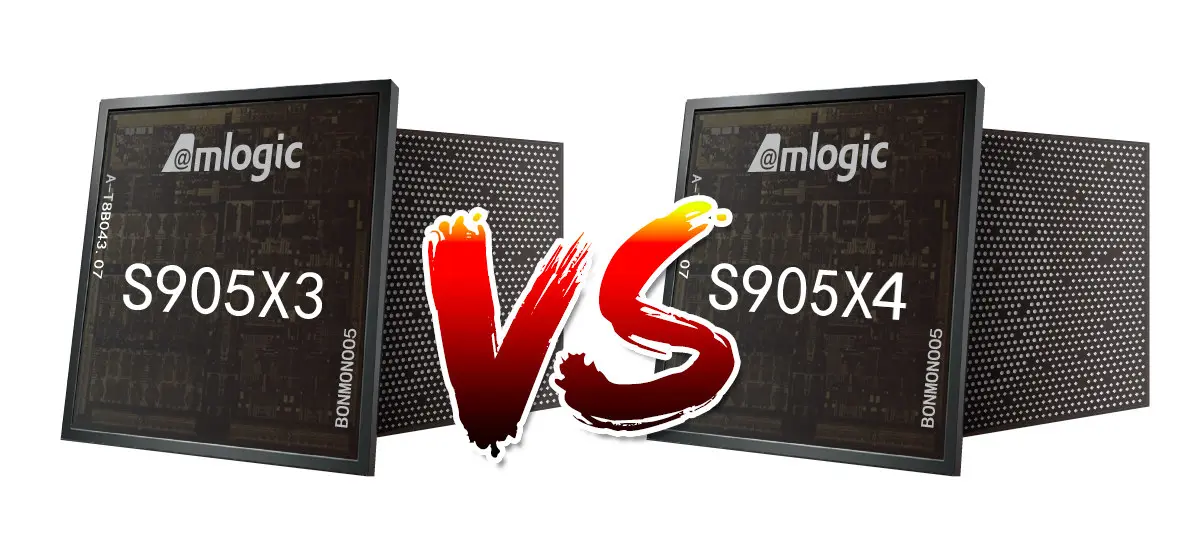AV1 capable Amlogic S905X4 processor has been expected for more than a year, and only now are we starting to see announcements of S905X4 TV boxes and development kits.
So it may be a good time to compare the features of the new Amlogic S905X4 processor again its predecessor, namely S905X3, and see if there are other notable differences apart from support for AV1 open video codec.

We’ll use data from S905X3 specifications, S905X2 vs S905X3 comparison, and a post on SDMC LinkedIn page.
| CPU | Quad-core Cortex-A55 up to 1.91 GHz | Quad-core Cortex-A55 up to 2.0 GHz |
| GPU | Arm Mali-G31MP2 with support for OpenGL ES 3.2, Vulkan 1.0/1.1, and OpenCL 2.0 | |
| Neural network accelerator | Optional 1.2TOPS NPU | N/A |
| Memory | DDR3-2133, DDR3L-2133, DDR4-3200, LPDDR3-2133, LPDDR4-3200 SDRAM up to 4GB | |
| Storage I/F | eMMC 5.0, NAND Flash, SPI NOR/NAND, SD | |
| Video Output | HDMI 2.1 up to 4Kp60, HDCP2.2, CVBS | HDMI 2.1 up to 4Kp60, HDCP2.3, CVBS |
| HDR | HLG/HDR10/ 10+ Dolby vision, TCH PRIME | |
| Audio | Stereo DACs, S/PDIF In and Out, 8-ch PDM, 12-ch PDM in, 12-ch PDM out | |
| Video Decoding | 10-bit H.265, VP9, AVS2 up to 4Kp75, H.264 4Kp30 | AV1 up to 4Kp120, 10-bit H.265, VP9, AVS2 up to 4Kp75, H.264 4Kp30 |
| Video Encoding | 1080p60 H.265/H.264 | |
| Voice & Audio Processing | VAD, ASRC/EQ/DRC | VAD, ASRC/EQ/DRC, 2x HiFi4 audio DSP |
| DRM & CAS | Widevine, PlayReady, VMX, Irdeto MSR 3.2 | Widevine, PlayReady, VMX, Irdeto MSR 3.2, Nagra NOCS3.2 |
| Ethernet | Gigabit Ethernet MAC, and 10/100M PHY | |
| USB and PCIe | 1x USB 2.0, 1x USB3.0 or PCI-E v2+USB 2.0 (multiplexed) | |
| Crypto Engine | AES, TDES, SHA-1/SHA-2/HMAC, SM4 | AES, TDES, SHA-1/SHA-2/HMAC, RCA |
| DVB | 2x Transport Stream (TS) inputs, ISO7816 smart card standard | |
| Process | 12nm | |
So from a user perspective, the only real difference will be support for 4K AV1 hardware video decoding that boosts efficiency by 20% compared to H.265/HEVC, and saves 30% bandwidth compared to H.265/VP9. Since AV1 is supported by Netflix, Amazon Prime Video, YouTube, and other online video streaming services, you may experience less buffering for the same video quality, or higher video quality for an equivalent bitrate.
Jean-Luc Aufranc (CNXSoft)

Comment